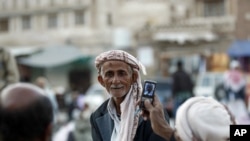GENEVA —
The United Nations refugee agency says it is seeing growing numbers of internally displaced people in southern Yemen return to their homes. The UNHCR says this is the first time since violence and civil strife broke out in early 2011 that so many people are deciding it is safe for them to go back to the homes they fled.
U.N. refugee spokesman, Adrian Edwards, says the UNHCR, together with the Yemeni authorities, has helped more than 80,000 internally displaced people go home over the past few months. And, he says the returns are ongoing.
“This is the first significant displacement decline since May of 2011 when fighting between government troops and militants erupted in this part of Yemen. It also follows the re-establishing of government authority in the southern province of Abyan in July. Initially, the returns were slow because of widespread presence of landmines and unexploded ordinance, as well as extensive damage to infrastructure in several areas. And, in many cases, people simply wanted to see more evidence of improvements before making the decision to return," said Edwards.
Inspired by the Arab Spring, violent protests broke out against the autocratic rule of Yemen’s former President, Ali Abdullah Saleh in January 2011. This turmoil later spread to the southern part of the country. A new president, Abed Rabbo Manoor Hadi was elected February 2012. However, ousted President Saleh reportedly is believed to still wield considerable influence in Yemen.
The UNHCR reports most of the 25,000 internally displaced who had been sheltering in schools and other public buildings in the port city of Aden have returned to Abyan. It notes the government is covering transportation costs for people returning there. And, security personnel are manning checkpoints along the route to ensure safe passage.
Edwards says the UNHCR and other agencies are providing further support. He says his agency in particular is distributing shelter repair kits to more than 30,000 people, as well as other relief items such as mattresses, blankets and kitchen sets.
“We plan to help 180,000 persons in Abyan with shelter and non-food relief kits. Currently, the challenges include widespread damage to property and infrastructure, a still fragile security situation, and patchiness in provision of public services. Continuing international support and stable security will be essential if these returns are to become sustainable, and particularly if internal displacement in southern Yemen is to be brought to an end during 2013," he said.
In the meantime, Edwards says the current situation for hundreds of thousands of homeless people in northern Yemen remains bleak. He says more than 300,000 people still are displaced from the conflict that has been running on and off since 2004 between the Yemeni government and Shi'ite al Houthi rebels.
He notes the situation in the north remains volatile and people feel too insecure to return home. Indeed, earlier this year, he says tribal clashes in the northern governorates forced more than 6,000 people to flee their homes.
U.N. refugee spokesman, Adrian Edwards, says the UNHCR, together with the Yemeni authorities, has helped more than 80,000 internally displaced people go home over the past few months. And, he says the returns are ongoing.
“This is the first significant displacement decline since May of 2011 when fighting between government troops and militants erupted in this part of Yemen. It also follows the re-establishing of government authority in the southern province of Abyan in July. Initially, the returns were slow because of widespread presence of landmines and unexploded ordinance, as well as extensive damage to infrastructure in several areas. And, in many cases, people simply wanted to see more evidence of improvements before making the decision to return," said Edwards.
Inspired by the Arab Spring, violent protests broke out against the autocratic rule of Yemen’s former President, Ali Abdullah Saleh in January 2011. This turmoil later spread to the southern part of the country. A new president, Abed Rabbo Manoor Hadi was elected February 2012. However, ousted President Saleh reportedly is believed to still wield considerable influence in Yemen.
The UNHCR reports most of the 25,000 internally displaced who had been sheltering in schools and other public buildings in the port city of Aden have returned to Abyan. It notes the government is covering transportation costs for people returning there. And, security personnel are manning checkpoints along the route to ensure safe passage.
Edwards says the UNHCR and other agencies are providing further support. He says his agency in particular is distributing shelter repair kits to more than 30,000 people, as well as other relief items such as mattresses, blankets and kitchen sets.
“We plan to help 180,000 persons in Abyan with shelter and non-food relief kits. Currently, the challenges include widespread damage to property and infrastructure, a still fragile security situation, and patchiness in provision of public services. Continuing international support and stable security will be essential if these returns are to become sustainable, and particularly if internal displacement in southern Yemen is to be brought to an end during 2013," he said.
In the meantime, Edwards says the current situation for hundreds of thousands of homeless people in northern Yemen remains bleak. He says more than 300,000 people still are displaced from the conflict that has been running on and off since 2004 between the Yemeni government and Shi'ite al Houthi rebels.
He notes the situation in the north remains volatile and people feel too insecure to return home. Indeed, earlier this year, he says tribal clashes in the northern governorates forced more than 6,000 people to flee their homes.








